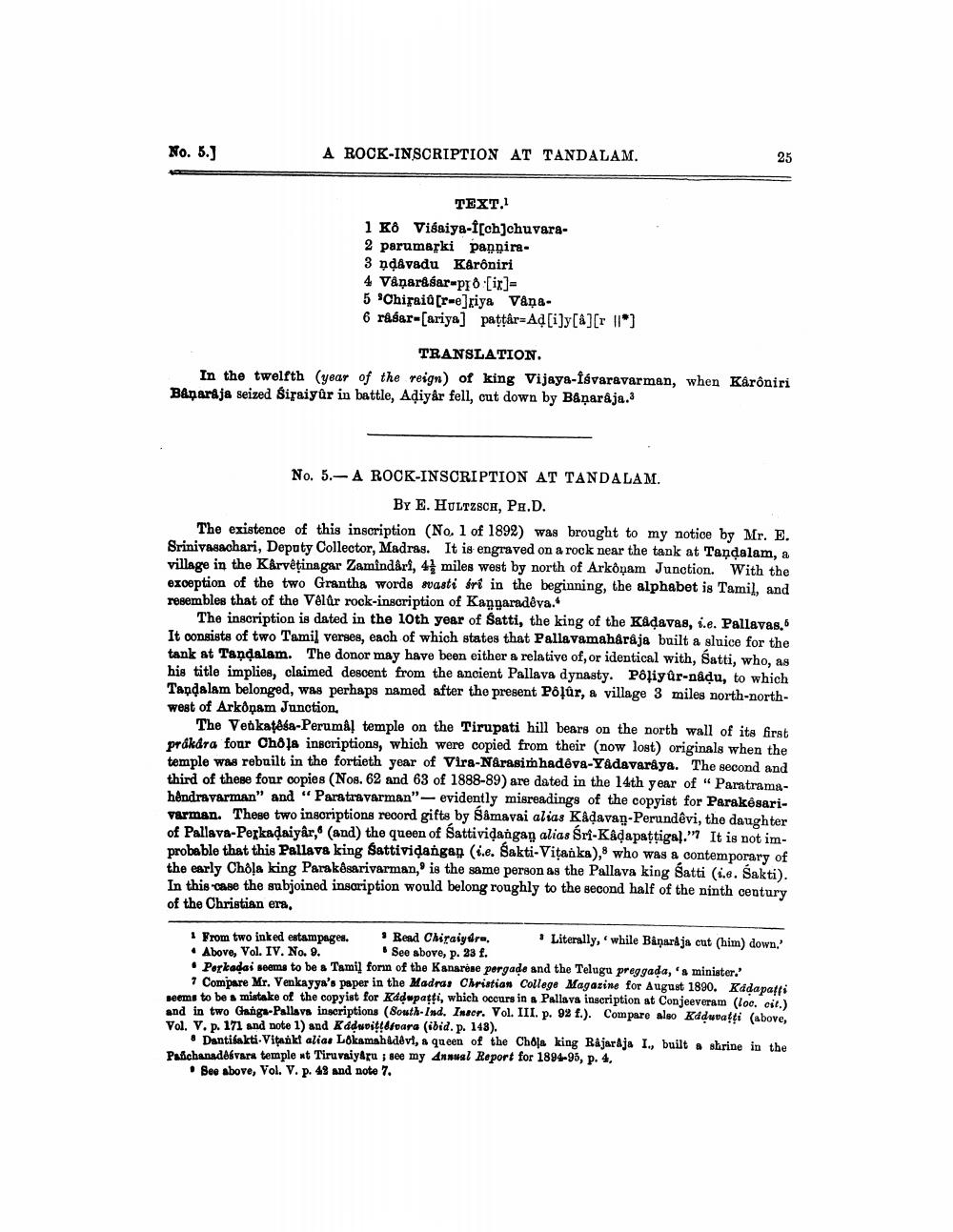________________
No. 5.
A ROCK-INSCRIPTION AT TANDALAM.
TEXT. 1 K6 Visaiya-i[ch]chuvara2 parumaski papnira3 nd&vadu Karôniri 4 Vånardsar-Pro [ir]= 5 'Chiraid[re]riya Vana6 raser-[ariya] patt&r=Ad [i]y[á] [r 11]
TRANSLATION In the twelfth (year of the reign) of king Vijaya-Isvaravarman, when Kârôniri Banaraja seized śiraiyur in battle, Adiyar fell, cut down by Banaraja.)
No. 5.- A ROCK-INSCRIPTION AT TANDALAM.
BY E. HULTZSCH, PH.D. The existence of this inscription (No. 1 of 1892) was brought to my notice by Mr. E. Srinivasachari, Deputy Collector, Madras. It is engraved on a rock near the tank at Tandalam, a village in the Kårvêtinagar Zamîndâri, 4 miles west by north of Arköŋam Junction. With the exception of the two Grantha words svasti srl in the beginning, the alphabet is Tamil, and resembles that of the Velar rock-inscription of Kangaradova.*
The inscription is dated in the 10th year of Satti, the king of the Kidavas, i.e. Pallavas. It consists of two Tamil verses, each of which states that Pallavamaharaja built a sluice for the tank at Tandalam. The donor may have been either a relative of, or identical with, Satti, who, as his title implies, claimed descent from the ancient Pallava dynasty. Poliyûr-nadu, to which Tandalam belonged, was perhaps named after the present Posûr, a village 3 miles north-northwest of Arkonam Junction,
The Venkatesa-Perumal temple on the Tirupati hill bears on the north wall of its first pråkdra foar Chola inscriptions, which were copied from their (now lost) originals when the temple was rebuilt in the fortieth year of Vira-Narasimhadêva-Yadavaraya. The second and third of these four copies (Nos. 62 and 63 of 1888-89) are dated in the 14th year of " Paratramahendravarman" and "Paratravarman"-evidently misreadings of the copyist for Parakesarivarman. These two inscriptions record gifts by Såmayai alias Kadavan-Perundêvi, the daughter of Pallava-Perkadaiyar, (and) the queen of Sattividangan alias Sri-Kadapattigal." It is not improbable that this Pallava king Sattividangen (i.e. Sakti-Vitanka), who was a contemporary of the early Chola king Parakåsarivarman, is the same person as the Pallava king satti (1.6. Sakti). In this case the subjoined inscription would belong roughly to the second half of the ninth century of the Christian era,
1 From two inked estampages. Read Chiraiysra. Literally, while Bånarája cut (him) down.' • Above, Vol. IV. No. 9.
See above, p. 23 f. • Porkadai seems to be a Tamil forn of the Kanarėse pergade and the Telugu preggada, 's minister.'
7 Compare Mr. Venkayya's paper in the Madras Christian College Magasine for August 1890. Kddapaffi seems to be a mistake of the copyist for Kadupatti, which occurs in a Pallava inscription at Conjeeveram (loo. cit.) and in two Change-Pallava inscriptions (South-Ind. Inscr. Vol. III. p. 09 f.). Compare also Kddwvaldi (above, Vol. V. p. 171 and note 1) and Kddwoitidoara (ibid. p. 148).
. Dantibakti. Vitankt alias Lökamahidevi, a queen of the Chola king Rajaraja I., built a shrine in the Prichanada vara temple at Tiruvaiyaru ; see my Annual Report for 1894-95, p. 4.
Bee above, Vol. V. p. 49 and note 7.




